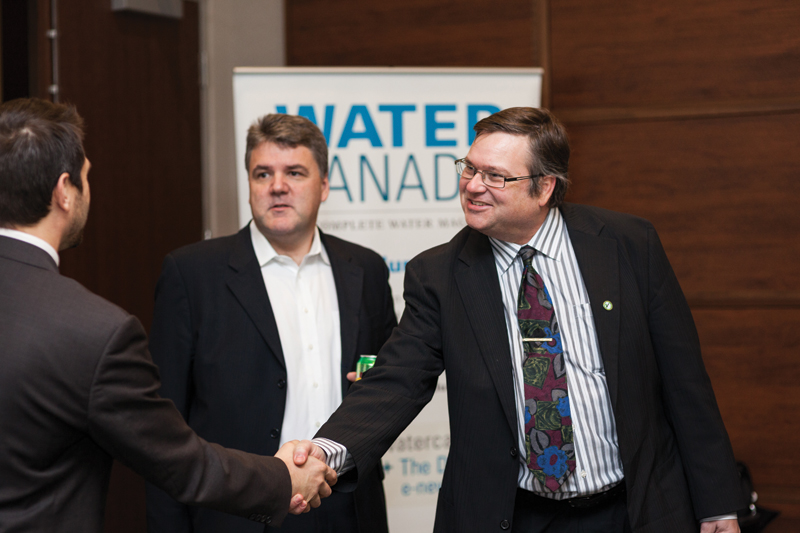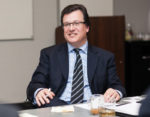As the infrastructure deficit exceeds capital and operational budgets, the leaders in charge of Canada’s municipal water and wastewater assets and operations are being asked to do more with less. User rates are not high enough to reflect the true cost of water infrastructure and operations and government funding alone—at all levels—can’t meet demand.
How can these leaders cope with expanding capacity to accommodate growth while replacing and repairing failing systems on a dime? In November, Water Canada and AECOM gathered a mix of municipal, academic, and business experts to discuss how the utility of the future can optimize the renewal and operation of existing assets.
Photos: Neil Ta
Asset management as a motivator
For many municipalities, the threat of losing access to funding is a great motivator for developing long-term sustainability plans for water and wastewater assets. In Ontario, for instance, the Province’s new municipal infrastructure strategy requires municipalities to provide detailed asset management plans as a prerequisite for receiving capital funding.
While some roundtable participants had issues with how it is being implemented, most viewed this legislation as a groundbreaking turn for the better.
“We’re starting to see mandating stewardship of assets in a few jurisdictions. These [plans] have existed overseas, but [the concept is] only emerging in North America. It’s a good start,” said Devan G. Thomas, associate VP, technical practice director of infrastructure services, water, AECOM. “Ten years ago, we would have never seen anything like this. Compare it to what’s going on in the United States with some agencies saying they’re not going to fund or legislate [municipalities] to do the right thing. They’re just not there yet.”
Even with Ontario’s mandate to integrate life-cycle planning, the major barriers to properly planning water infrastructure continue to be political. “You have to educate your board of directors, your councillors [about asset management], because they’ll ask why you’re spending money to do another study instead of just building to expand capacity,” said John Presta, director of environmental services at the Regional Municipality of Durham. “There’s a learning curve there.”
Politics and silos
Communicating across departments is another challenge, said Mike Hausser, director of asset management and support services for the City of Cambridge. “One of the greatest challenges we face in municipalities is the silo effect. The larger your municipality or the larger your utility, the more fortified those silos become.”
“When you look at coordinating your capital side of things—and maybe some of the maintenance side, too—coordinating your renewals between the multiple utilities is exceptionally difficult. It’s a balancing act.”
Toronto Water’s Annette Kopec provided an example. “We have assets in the ground that are greater than 100 years old that are in excellent condition. However, in congested corridors, these assets are disturbed due to adjacent construction and subsequently need to be replaced,” said the manager of capital programming, water infrastructure.
Defining the life cycle of varying assets is a challenge as it is impacted significantly by asset material, ground conditions, construction specifications at the time of construction, how well they were constructed, and maintenance undertaken,” said Kopec.
Hausser agreed. “If you dig a hole to fix one thing, whatever’s next to that hole is likely to fail next. You can trench one utility, but as soon as you’re into two underground utilities that need rehabilitation, you’re into a full reconstruct. There’s no point in digging out two pipes and leaving a third. With the amount of disruption, you’ll destroy that third one and have to cut in ten years later anyway.”
“The more you build up these silos, the more times you’re going to dig that same hole in the ground—it’s a complete waste of money,” said Hausser.
The collaboration-optimization loop
Avoiding multiple digs is one reason the City of Cambridge is working with IBM to build a tool that helps better coordinate all of the City’s renewal activities in the short, medium, and long terms, said Hausser. “If I’ve got a million bucks to spend, how can I best spend it maximizing the return on investment?” If municipalities keep data for all of their assets, they can better optimize their decision-making processes.
“We have a deficit of funding, we had a deficit of legislative drivers—they’re coming to the fore now—and we probably have a deficit of collaboration within the industry,” said Thomas. “If all of those things come down, we can start leveraging the technology that exists, like the investments municipalities have made in GIS information bases, and really start to improve how we manage our infrastructure.”
Geoff Riggs, manager of Smarter Water business development at IBM Canada, said building a system for data collection could help lead to better collaboration between the parties responsible for management of municipal assets. “Utilities that are talking to each other can often reveal opportunities for cross-pollination. For example, you realize that you could be running one system instead of two, shedding some operating costs from the technology perspective.”
The power of an accurate inventory
Of course, collaboration isn’t easy without a base knowledge of the state of water assets. “When nobody knows what’s in the ground, how are you supposed to allocate funds, and to which projects?” asked Lesley Herstein, a PhD candidate from the University of Toronto’s department of civil engineering.
Many municipalities see the prospect of making the switch from reactive maintenance to proactive planning as a pipe dream. “You’ve got water leaking in multiple locations of the city. Which holes are you going to plug first when you have limited resources to repair them?” asked Hausser. A good first step is an accurate inventory of water infrastructure—in fact, it’s a necessity for good plan of attack. Without a database showing the location and state of all assets, it’s impossible to begin to prioritize maintenance and replacement, which helps avoid major failures; failures that end up costing a city more than routine maintenance or sometimes even replacement.
“An hour of down time for the oil and gas industry [costs] millions. They can’t afford that kind of risk,” said Riggs, who is applying some of the same technologies and approaches to Cambridge’s systems as it would to a massive private operation. “We’re trying to build resilience into systems so we can better predict which assets are going to fail, and when, so they can order the parts from the overseas manufacturer in advance. Everything is lined up proactively and the operation continues to run.”
In industrial operations, this method may work well—especially when the equipment is new and monitored from the moment it is installed. But the predictability of water asset life cycles in cities is sometimes impossible, Hausser argued. “You can have two post-war era cast iron pipes in the ground with multiple breaks and the other, installed the next year by the exact same contractor, is solid. Why? The first pipe was lowered using chains and the material was scarred and it quickly corroded.”
Riggs admitted that condition-based monitoring isn’t necessarily a crystal ball, and Thomas offered an additional approach.
“In the absence of being able to say definitively when an asset will fail, we have to look at the impact of that asset failing versus another asset,” said Thomas. “Probability of failure times consequence equals risk. That drives your response to the programs. If you have an asset that has low consequences of failure and perhaps redundancy, you can live with reactive maintenance. If it’s a high-impact (high-consequence) asset, you’d better be targeting your rehab and inspection strategies there.”
Speaking from his experience at the City of Cambridge, Hausser reminded Thomas that, while this math makes sense in theory, all assets are still connected. “You have to ensure that you are operationally available and ready to increase your reactive modes,” he said. “In Cambridge, we have a higher loss of water from water services breaking than mainlines, for a number of reasons. Based on the housing stock and the years it was built, we have some idea of future break rates and what future reactive resources are needed to be available to respond.”
“We’re not just into capital planning, we’re into how we’re going to manage the operations. We don’t want all the proactive measures go out the window because we’re too busy fixing leaks. We want to maintain the proactive activities and yet we want to respond with reactive measures knowing that we’re going to let some areas run to failure. We need the operational capacity and the funding to deal with it. You have to plan and manage both ends.”
Finding capacity before undertaking big builds
Sometimes, the best way to increase efficiency in the short term can be to make tweaks to existing assets.
“In Durham Region, we’ve used optimization studies for our wastewater plants,” said Presta. “We have 12 wastewater plants of various sizes from serving hundreds of people to hundreds of thousands of people. The needs of these different size plants vary, so we need to investigate ways of getting the most of each plant prior to expansion. We’ve been able to capture approximately 15 to 20 per cent additional capacity with a fraction of the cost of building new capacity. It has helped us defer or spread out the investment on the facility, plus we can plan better and use it more efficiently.”
IBM recently worked with a mid-sized U.S. municipality that perceived that it did not have sufficient capacity to handle combined sewer overflows (CSO). The Environmental Protection Agency has significant fines associated with CSOs, and Riggs said the municipality was looking at nine-digit infrastructure costs to solve the issue.
“They had real-time controls in place, but were using them with a brute force kind of method. Weather event coming, open all the valves; dry weather expected, close them,” said Riggs. “We optimized the controls and identified existing capacity in the system.”
These were relatively small solutions, and Riggs said that’s one of the nice things about enhancements—they don’t have the physical costs associated with digging. “A lot of the times, the information is there. If you track the real-time conditions, you can reveal efficiencies that were right in front of you.”
Is there room for innovation?
“In the complex, resource and capital constrained municipal world, is there a role for innovation and start-up technology companies?” asked Usha Srinivasan of MaRS Discovery District, who came to the table representing entrepreneurs. “If a technology solution can help optimize your needs, will there be more interest?”
“Each municipality is like its own little tribe—it’s hard for bigger companies to template packaged solutions that work everywhere. I think a really neat model is to engage local technology providers,” said Riggs. “There are certain species that exploit certain niches, and local tech providers presumably know the local environment and specific needs better. As much as we try, you’ll never have a single-template smarter city solution—you need that local specialization. There are a lot of entrepreneurs out there, and they play a vital role.”
It’s not just capital constraints and silos—adopting new tech is also a question of taking risks, which is not traditionally part of any municipality’s wheelhouse and requires a lot of extra work.
“If a group wants to pilot something with us, I can’t just say ‘go ahead and do it,’” said Presta. “Municipalities are generally risk-averse and their bureaucratic approval process is not designed for innovation. The business processes need to be changed in order that timely decisions can be made. If senior staff members are provided with the approved delegated authority to make certain operational decisions, an environment of shared innovation can develop.”
Hausser said there should be a budget line for research and development. Cambridge has one, but it’s on an as-needed basis. “You have to fight for it each time,” he said. “We’re too busy fighting fires and trying to keep things going. We’re so backlogged—just trying to solve the basic problems. Finding extra time to deal with interesting possibilities is really hard.”
Can a system work too well?
Tighten a bolt here, add a new widget there—it’s all part of avoiding big digs and deferring comparatively expensive build outs. Participants also agreed that managing demand is another important element of the optimization package. But conservation measures and user rate structures aren’t exactly compatible. Even the most efficient system requires revenue for maintenance and operation.
Said Kopec of her experience at Toronto Water: “Water users are increasingly aware of their water consumption and are adjusting their use of water. Rate increases are not generating comparable revenue increases as consumption continues to decline on a per capita basis. This is having a remarkable impact on how we’re able to finance our program.”
While the revenue riddle will require creative solutions—ones that will be discussed in a future roundtable, to be sure—most participants agreed that the return for examining existing systems and addressing efficiencies was well worth the cost. WC


















You don’t have to look any further than the new sewage works planned for Victoria BC if you want an example of ‘failure to optimize’.. the designers have refused to consider the competitiveness of their design v. a long-proposed commercial sewage reclaim pipeline that would be energy self-sufficient and earn $M’s by integrating with a stand-alone pumped storage hydro plant and other revenue-generating operations.. apparently, it makes more sense to produce an $800 M bag of fertilizer with their waste management and energy monoplies than to allow an entreprenuer to get his foot in the door..